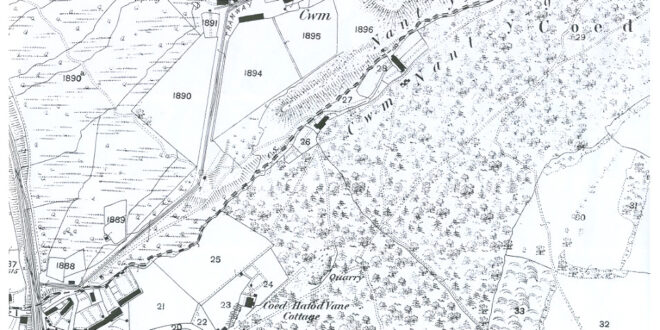Cwm Nant-y-Groes Coal Level.
Situated up in the Cwmnant-y Groes area of Six Bells, the colliery is featured on the 1843 map of the coalfield as being in production and had a tramway to the main tram road at Six Bells.
 Messrs T. P. & D. Price.
Messrs T. P. & D. Price.
The coal level was opened by Messrs T. P. & D. Price. Mr Thomas Protheroe Price and Mr David Price were brothers, coal owners and merchants of Brecon and original owners of the Penybont Tillery Colliery in the 1840’s. The news item (as seen above) is from October 1857 and proof they were the early owners the Cwmnant-y-Groes Levels at Six Bells.
Messrs Clapp & Williams.
In 1864 Messrs Clapp & Williams were proprietors of the Tillery Coal Level. Messrs Clapp and Williams were – Mr William Murray Clapp born in 1799 at Northumberland, later a coal merchant from 18 Cardiff Road, Newport, Monmouthshire and Mr Phillip Alfred Williams a founder and chairman of the Abertillery Local Board and also a Guardian of the Parish of Aberystruth.
Messrs Clapp & Williams and Co.
In 1869 Cwmnant-y-Groes Colliery and the Tillery Collieries Levels were listed as being owned by Messrs Clapp and Williams – Clapp & Williams and Co.
Messrs Clapp & Co.
In 1876 the colliery was listed as being Messrs Clapp & Co. It was listed as being one of the collieries in Group No.2 of the South Wales Collieries and at this time the price for cutting coal was 2s. 3d. per ton.
 The Coal Cutting Machine.
The Coal Cutting Machine.
On Thursday 9th of March 1876, Mr W. J. Clapp (son of the owner of Mr Clapp & Co) tested a new coal cutting machine that he had invented. The machine was made in the workshops of Messrs Tangye Bros & Steel, engineers of Newport , a block of coal taken from Cwmnant-y-Groes Colliery was used to demonstrate its use in front of many invited guests. The guest list included the following – Mr Lionel Brough (Inspector of Mines); Mr Thomas Cadman (Deputy Inspector); Mr T. Dyne Steel (Partner in the Company of Tangye Bros & Steel); Mr Wilkinson C.E.; Mr Llewellyn; Mr Ward (Solicitor); Mr Lewis and others: Also present were the representatives from the Powell Duffryn Coal Company.
Description of the Coal Cutting Machine.
The coal cutting machine was propelled by steam on rails and featured a series of borers placed horizontally in a frame, the borers would drill a number of holes into the bottom of the coal face taking 6 to 7 minutes then moved forward to bore another batch of holes and so-on, the colliers would come behind and wedge out the blocks of coal. During the experimental cut the machine bored out a block of coal 6’ft 2″ins long, 3’ft 8″ins wide by 2’ft 2″ins thick and weighing 1 ton 13cwt. There was criticism of the size of the machine, it was considered too bulky to use in many smaller collieries.
Messrs Clapp & Co.
In February 1883 Messrs Clapp and Williams partnership was officially dissolved. Though in 1896 the Cwmnant-y-Groes Colliery was still under the ownership of Messrs Clapp & Co, there were twenty-four men employed below ground and six on the surface.
Messrs Webb’s, Aberbeeg.
In 1898 the Cwmnant-y-Groes Colliery was under the control of Messrs Webb’s, Aberbeeg.
Mr William Gay.
In 1908 Mr William Gay of 19 New Princess Street Abertillery was the owner and there were just six men employed below ground with none on the surface.
In 1918 the Cwmnant-y-Groes Colliery was not listed.
The Cwmnant-y-Groes Colliery Tramway.
The tramway from the Cwmnant-y-Groes Colliery came across the side of the mountain north-west towards the Cwm Farm area to the White House – which was originally an engine house for the colliery. The trams of coal were dropped down the incline which is now where Coronation Road and Eastville Road is today and down to the railway above the Coach & Horses Inn. The inn at this time was set back against the railway about where the subway is today.
In the 1870’s the railway company wanted to widen the railway up through the valley from a single track to a double one to accommodate the increase in traffic. The Coach & Horses Inn was demolished to make way for this expansion and rebuilt on the side of the riverbank where it is today.
 Messrs A. West and H. Weaver.
Messrs A. West and H. Weaver.
In January 1931 Messrs A. West and H. Weaver gave notice that they were to re-open the Cwmnant-y-Groes Levels and were given permission by the council to access them and the airshaft, via council owned property.
The waste from this level was dumped close to the levels in the valley, later the tips were flattened, levelled and made into the sports fields.
Points of Interest – The name Cwmnant-y-Groes was written in many different ways in old papers, i.e., Cwm-Nantygroes, Cwmnantygroes, Cwmnan-ty-groes etc. I have spelt it as Cwmnant-y-Groes for consistency.
 Out Of The Blue Artifacts A Library of a lifetime of collecting
Out Of The Blue Artifacts A Library of a lifetime of collecting
